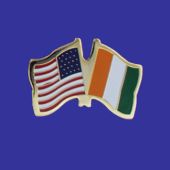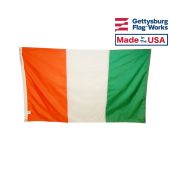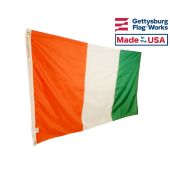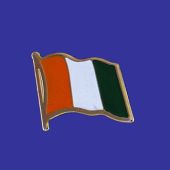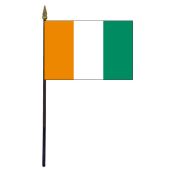Flag of the Ivory Coast (Cote d'Ivoire)
Flag of Ivory Coast
The flag of Ivory Coast reflects the flags of the many nations that have influenced it during its history. It combines those foreign influences with symbols of the nation itself in order to create an Ivory Coast flag that represents both the modern country and the history that it shares with the rest of the world. It also bears a strong resemblance to the Irish flag, but the similarity is purely coincidental.
The flag of the Ivory Coast was adopted in 1959, just prior to independence.
- Capital of the Ivory Coast: Yamoussoukro
- Area of the Ivory Coast: 318,000 sq. km
- Languages used in the Ivory Coast: French (official), 60 native dialects including Dioula
- Religions in the Ivory Coast: Christian, Muslim, indigenous beliefs
Colors and Symbolism of the Ivory Coast Flag
The Ivory Coast flag is a vertical tricolor of orange, white, and green without any emblems. The orange stripe stands for the nation's land, especially the savanna that dominates the northernmost parts of the country. The white band is a symbol of peace. The green stripe represents the forests that dominate the southern portion of the nation as well as hope for the future. The vertical tricolor pattern is derived from the flag of France, which once ruled over the nation, so it serves as a symbol of the country's past. The flag of Ivory Coast uses the same color scheme as the flag of Niger, which represents the bond between the two countries.
History of Ivory Coast Flags
The first Ivory Coast flag to see regular use was the French flag, which represented the nation while it was a French colony. The government of France did not use colonial flags in order to prevent them from encouraging nationalist sentiment in the colonies, so the country did not have a unique flag until the end of the colonial period.
The modern flag of Ivory Coast dates back to 1959, when a large number of nations in Africa won their independence from their colonial overlords. The flag's adoption slightly predates the formal recognition of the country's independence, which occurred in 1960. The flag is an anomaly in West Africa in that it does not feature the colors of the Pan-Africa movement like the vast majority of the flags used by neighboring nations. The government chose the distinctive design in spite of the fact that it maintained a loose alliance with many other new African nations that chose to use the Pan-African colors as a sign of solidarity with each other and the rest of Africa. The government's unique design was a popular choice, and it has not been changed since it was first adopted.
